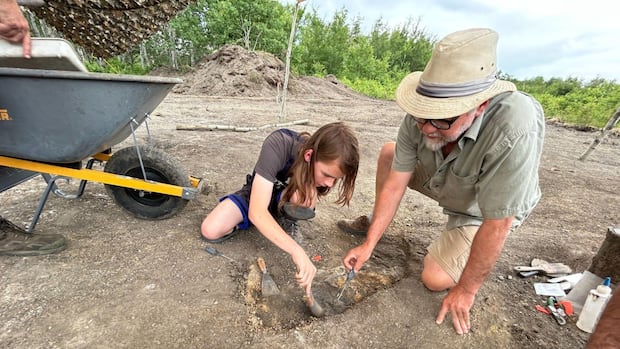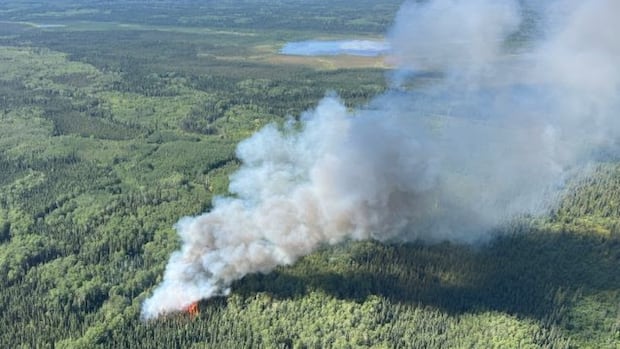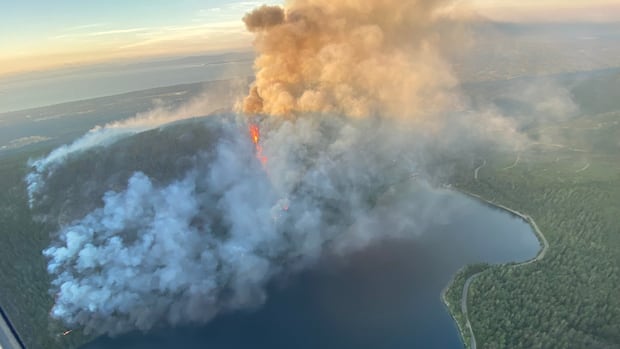At least 4,000 people have evacuated their homes and communities due to aggressive wildfires in northern Saskatchewan.
The largest group of evacuees has fled the northern village of Pelican Narrows, about 400 kilometres northeast of Prince Albert, where a wildfire burns dangerously close to the community and threatens road access.
- Poor Internet connection? CBC Lite is our low-bandwidth website.
Cherish Morin, a resident from Pelican Narrows, arrived at a Saskatoon hotel early Tuesday morning. She said packing up and leaving her home behind was stressful.
“There’s lots of people at the gas station gassing up. Everyone was in the panic mood,” Morin told CBC Tuesday.
Peter Ballantyne Cree Nation declared a state of emergency on Tuesday for Pelican Narrows. Chief Peter Beatty told CBC News about 2,000 people had left Pelican Narrows and surrounding communities already and another 2,000 were being told to leave immediately, either by bus or in their own vehicles.
Evacuation centres have been set up in Prince Albert, Flin Flon and Saskatoon.
People are advised to check the province’s Highway Hotline before travelling. Some highways are permanently closed, and others have been intermittently closed due to smoke or nearby fires.
Morin said Highway 106 was closed Monday evening, which forced her to take a road near La Ronge, adding extra travel time.
“Me and my partner got into Saskatoon around 2 a.m. and then we had to scatter around looking for rooms.”
Now, in Saskatoon, she is hoping for the best – that her home will go unscathed.
“I’m very stressed out about the whole situation. Like, very worried because my grandpa decided to stay back to be security.”
Morin said she’s also worried about the other houses in her community and the people, like her grandfather, who have decided to stay and help.
“I just hope like they can get the fire under control and then we can go home.”
Sask. fire threatens Flin Flon
People in Flin Flon, Man., have been given a pre-evacuation notice and high-acuity patients are already being moved out of the hospital, after a wildfire that started in Saskatchewan on Monday crossed over into Manitoba on Tuesday.
Intense fire conditions limited the resources the province was able to send on both sides of the provincial border, officials said.
An aircraft was also grounded due to a drone in the airspace over the fire.
Manitoba Premier Wab Kinew emphasized that everyone needs to put the good of the community ahead of their own interests.
“Getting some views on YouTube is not worth it. You’ve got a community, thousands of people who are on the verge of evacuation. And one of the reasons is because we couldn’t fly water bombers in the area,” he said. “Putting your drone up there and getting a video that you can share is simply not worth it.”
Historic wildfire season: SPSA
Meanwhile, more than 380 people left the northern community of Hall Lake on Monday due to another wildfire.
In northwestern Saskatchewan, leaders in Canoe Lake, about 120 kilometres north of Meadow Lake, decided to evacuate after a fire started very close to the community on Monday. About 250 people have been moved to Cold Lake, Alta., and another 250 people to Lloydminster.
“We have not seen a fire season with as much impact and activity in the last couple of decades,” said Steve Roberts, vice-president of operations for the Saskatchewan Public Safety Agency (SPSA), on Tuesday afternoon.
As wildfires rapidly advance in Saskatchewan, communities like Candle Lake are growing anxious. Candle Lake officials say they’ve asked the Saskatchewan Public Safety Agency (SPSA) for permission to build a protective firebreak along Highway 120, to protect the resort village, along with Paddockwood.
Roberts said almost every single fire so far was caused by humans.
As of just before noon CST on Wednesday, there were 17 active wildfires in the province. Ten of those fires were not contained. The Denare Beach area — not far from the Saskatchewan-Manitoba border — has the most un-contained wildfires in the province, with four burning.
Two fires that have been burning in the Narrow Hills Provincial Park area — the Camp fire and Shoe fire — have now merged into the largest fire in the province. The huge fire has prompted evacuations at Lower Fishing Lake, Piprell Lake, East Trout Lake, Little Bear Lake, and pre-evacuation alerts for Candle Lake and other smaller communities.
The number of fires this year to date is significantly higher than in 2024, with 205 fires since the beginning of the year. That’s up from 165 last year during the same period, according to the SPSA.
In a news release issued Tuesday afternoon, the city of Saskatoon said the Cosmo Civic Centre is closed to the public, and is now a designated evacuation site.
The costs associated with hosting the evacuees will be billed to the Canadian Red Cross.








